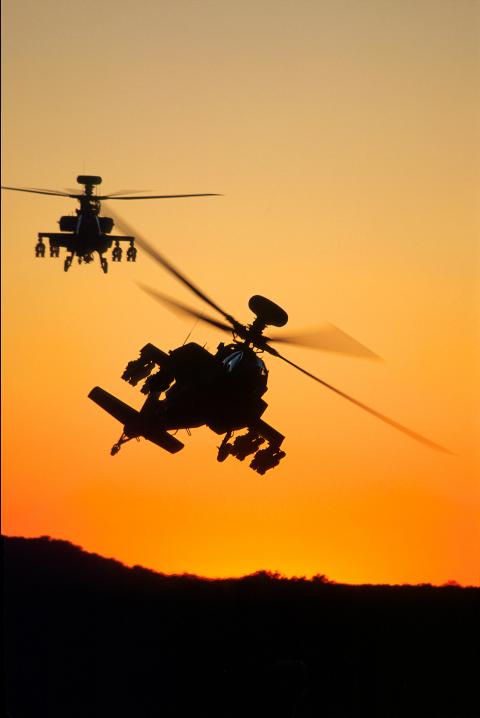The Taiwanese army earlier this year took delivery of the first of 30 Apache combat helicopters from the US and next month pilots and crew will begin training on the platform, which recently received a new designation from the US Army.
As a result of the significant upgrades made to the AH-64D Block III Apache during its development, the US Army recently decided to re-designate it the E model. To date, 25 AH-64Es have been delivered to the US Army and Taiwan received its first delivery during a low-key handover ceremony at Boeing Co’s Mesa facilities in Arizona in May.
According to Aviation Week, training for Taiwanese pilots and crews is expected to begin next month.

Photo courtesy of Boeing Co.
Following approval by the US government in August of contracts for full production of the helicopter, Boeing is now building four AH-64Es per month for the US Army, which plans to buy a total of 690, and three for foreign military sales (FMS). The US has also notified Congress for the sale of eight AH-64Es to Indonesia, 22 to Qatar and 22 to India, the latter under a non-FMS “hybrid” agreement.
If tests at the Naval Air Station China Lake in California last year are any indication, Taiwan’s AH-64E will be a far more formidable combat helicopter than its predecessors. During the drills, the E model reportedly countered realistic air defense threats and was able to maintain its position, unlike the Block II Apaches, which was “shot down” in similar exercises.
“The Block III absolutely frustrated these folks that operate these [air defense] systems,” Colonel John Lynch, attack helicopter manager at Army Training and Doctrine Command, told Aviation Week.
This was partly due to the aircraft’s ability to operate at lower altitudes and thus evade radar systems arrayed against it.
Part of the Echo model’s advantages are its improved composite main rotor blades, which are 15cm longer than those used on older models, as well as a new tip design and General Electric T700-GE-701D engines, all of which give the aircraft improved aerodynamic performance.
The AH-64Es’ new power-to-weight ratio also makes it safer for operations at low-levels and gives it a performance similar to that of the AH-64A, which was significantly lighter than the AH-64D Block II model, Lynch told Shephard Media, a defense and aerospace publication.
Taiwan’s 30 Apache helicopters, administered under a program named “Sky Eagle,” were included in an October 2008 notification to US Congress for about US$2.5 billion. Full delivery of the multirole attack helicopters is expected to be completed in 2017.

Taiwan is to commence mass production of the Tien Kung (天弓, “Sky Bow”) III, IV and V missiles by the second quarter of this year if the legislature approves the government’s NT$1.25 trillion (US$39.78 billion) special defense budget, an official said yesterday. Commenting on condition of anonymity, a defense official with knowledge of the matter said that the advanced systems are expected to provide crucial capabilities against ballistic and cruise missiles for the proposed “T-Dome,” an advanced, multi-layered air defense network. The Tien Kung III is an air defense missile with a maximum interception altitude of 35km. The Tien Kung IV and V

The disruption of 941 flights in and out of Taiwan due to China’s large-scale military exercises was no accident, but rather the result of a “quasi-blockade” used to simulate creating the air and sea routes needed for an amphibious landing, a military expert said. The disruptions occurred on Tuesday and lasted about 10 hours as China conducted live-fire drills in the Taiwan Strait. The Civil Aviation Administration (CAA) said the exercises affected 857 international flights and 84 domestic flights, affecting more than 100,000 travelers. Su Tzu-yun (蘇紫雲), a research fellow at the government-sponsored Institute for National Defense and Security Research, said the air

A strong continental cold air mass is to bring pollutants to Taiwan from tomorrow, the Ministry of Environment said today, as it issued an “orange” air quality alert for most of the country. All of Taiwan except for Hualien and Taitung counties is to be under an “orange” air quality alert tomorrow, indicating air quality that is unhealthy for sensitive groups. In China, areas from Shandong to Shanghai have been enveloped in haze since Saturday, the ministry said in a news release. Yesterday, hourly concentrations of PM2.5 in these areas ranged from 65 to 160 micrograms per cubic meter (mg/m³), and pollutants were

Taiwan’s armed forces have established response protocols for a wide range of sudden contingencies, including the “Wan Chun Plan” to protect the head of state, the Ministry of Defense (MND) said today. After US President Donald Trump on Saturday launched a series of airstrikes in Venezuela and kidnapped Venezuelan President Nicolas Maduro, concerns have been raised as to whether China would launch a similar “decapitation strike” on Taiwan. The armed forces regularly coordinate with relevant agencies and practice drills to ensure preparedness for a wide range of scenarios, Vice Minister of National Defense Hsu Szu-chien (徐斯儉) told reporters before a